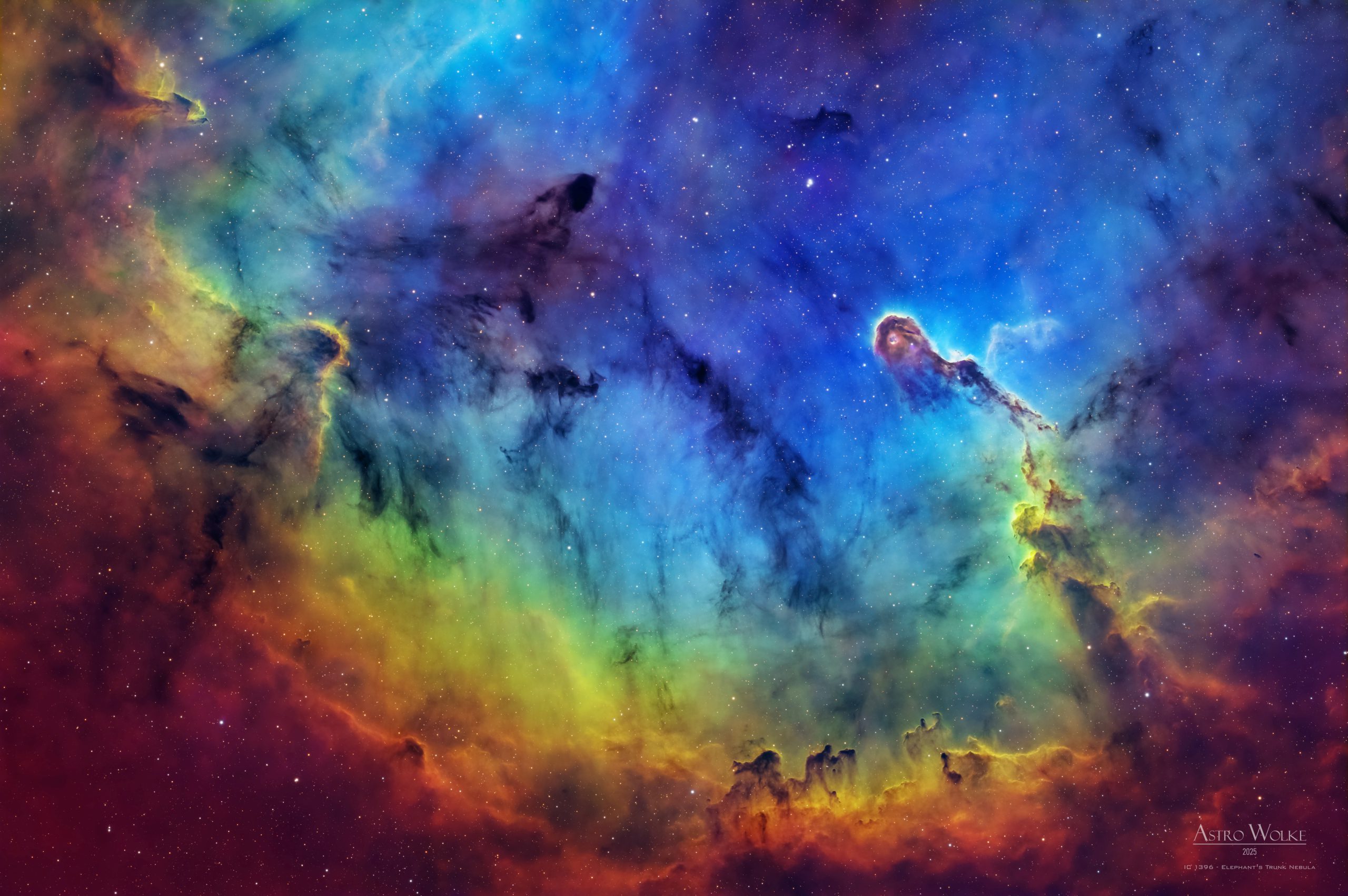In the constellation Cepheus, about 2,400 light-years from Earth, lies a vast star-forming region: the emission nebula IC 1396. Spanning nearly three degrees across the sky—six times the diameter of the full Moon—it combines glowing clouds of gas, dark dust lanes, and newborn stars into one of the most striking celestial vistas in the northern Milky Way.
Especially striking is the dark, pillar-like structure on the right: the Elephant’s Trunk Nebula (IC 1396A). Inside, dense pockets of gas and dust are collapsing to form new stars. Powerful stellar winds and ultraviolet radiation from hot, young stars carve these long filaments and arcs—sculpted, as it were, by a cosmic breeze.
The colours in this image are produced using narrowband filters (H-alpha, [O III], and [S II]) that isolate the light of specific elements. Hydrogen appears green, oxygen blue, and sulphur red — known as the “Hubble Palette” (SHO mapping). This technique reveals intricate structures in the gas that would otherwise be invisible in natural light.
At the centre of IC 1396 lies the hot O-type star HD 206267, whose intense radiation energizes the entire nebula. Its presence also triggers the birth of new stars within the dense columns—an impressive example of the cosmic cycle of stellar creation and destruction.
This image is not only a spectacle of colour but also tells the story of a cosmic nursery, where the material for future generations of stars and planets is taking shape—about 15 trillion kilometres away, yet a reflection of the universe’s eternal cycle of creation.
IC 1396 – Der Elefantenrüssel im Sternenmeer
Im Sternbild Kepheus, rund 2 400 Lichtjahre von uns entfernt, liegt ein gewaltiges Sternentstehungsgebiet: der Emissionsnebel IC 1396. Er umfasst fast drei Grad am Himmel – das entspricht dem Sechsfachen des Vollmonds – und vereint leuchtende Gaswolken, Dunkelnebel und junge Sterne zu einer der eindrucksvollsten Himmelslandschaften der nördlichen Milchstraße.
Besonders auffällig ist die dunkle, säulenartige Struktur im rechten Teil des Nebels: der sogenannte Elefantenrüssel-Nebel (IC 1396A). In ihm verbergen sich dichte Gas- und Staubregionen, aus denen neue Sterne hervorgehen. Starke Sternenwinde und ultraviolette Strahlung junger, heißer Sterne im Inneren des Nebels formen diese langen Filamente und Bögen – wie vom kosmischen Wind geschnitzt.
Die unterschiedlichen Farben auf dieser Aufnahme entstehen durch spezielle Schmalbandfilter (H-Alpha, [O III] und [S II]), die gezielt Licht bestimmter Elemente erfassen. Wasserstoff leuchtet hier grünlich, Sauerstoff blau und Schwefel rot – eine sogenannte „Hubble-Palette“ (SHO-Darstellung). Dadurch werden feinste Strukturen im Gas sichtbar, die im natürlichen Farblicht verborgen blieben.
Im Zentrum von IC 1396 befindet sich der heiße O-Stern HD 206267, dessen energiereiche Strahlung die gesamte Region zum Leuchten bringt. Seine Geburt markiert zugleich den Beginn der Entstehung neuer Sterne in den dichten Säulen des Nebels – ein eindrucksvolles Beispiel für den Kreislauf von Sternentstehung und -zerstörung.
Diese Aufnahme zeigt nicht nur ein beeindruckendes Farbspiel, sondern erzählt die Geschichte eines kosmischen Kinderzimmers, in dem sich das Material für kommende Generationen von Sternen und Planeten formt – rund 15 Billionen Kilometer entfernt, aber dennoch ein Spiegel des ewigen Werdens im Universum.
Conclusion
Details
Total Integration: 12h
Ha: 45x300s (13h 55’) 16.05.2025
OIII: 47x300s (10h 10’) 02.10.2025
SII: 52x300s (5h 40’) 03.10.2025
FOV: 2.16° x 1.44°
Pixel scale: 1.26″/pixel
Dithering: 2 pixels every image
Gain: 100
Sensor temperature: 0°C
Recording: ZWO ASI 2600MM DUO
Filter: Baader Highspeed 2″ Ha, Oiii, Sii
Optics: RASA 11″ V2
Guiding: ASI 220
Mount: iOptron CEM 120
Control: ZWO ASIAIR Plus
Software: PixInsight + Photoshop
Darks: 30
Flats: 20
Flat-Darks: 20


Comments are closed